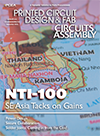News
LOHJA, FINLAND -- Elcoteq is discussing a range of options for the EMS provider's operations in Finland, including layoffs of up to 500 workers and the possible closure of its Lohja manufacturing plant.
Elcoteq employs about 23,000 workers worldwide, about 700 in Finland.
The company previously announced it would reduce overhead costs by about 20 million euros per year.
The company's board has proposed moving its headquarters to Luxembourg, which is known as a corporate tax haven.
Elcoteq employs about 23,000 workers worldwide, about 700 in Finland.
The company previously announced it would reduce overhead costs by about 20 million euros per year.
The company's board has proposed moving its headquarters to Luxembourg, which is known as a corporate tax haven.
EL SEGUNDO, CA – After increasing its holdings of excess semiconductors during the first half of the year, the electronics supply chain finished 2006 with its highest level of end-of-year overstock in five years, says iSuppli.
ATLANTA – The Surface Mount Technology Association Atlanta Chapter announced a free panel session, Busting the Myths of Supply Chain Management, will be featured April 19 at the chapter’s annual trade show. Panelists are Wendy Causey from Arrow Electronics, Chris Ellsworth from World Micro Components and David Scruggs of New Age Electronics. The one-hour session will discuss the three main layers of the supply channel: the manufacturer’s rep, the franchise distributor and the hybrid distributor. The SMTA Expo is a free, one-day event on April 19 at the Gwinnett Civic Center in Duluth, GA. For information on exhibiting or attending, visit http://smta.org/education/vendor_days/vendor_days.cfm.
REDWOOD CITY, CA – Component maker EoPlex Technologies has closed an $8 million Series C round. ATA Ventures led the financing along with current investors Draper Fisher Jurvetson, Labrador Ventures and Draper-Richards. EoPlex produces components in layers using custom printing equipment and proprietary inks.
YAVNE, ISRAEL – Valor Computerized Systems reported fourth-quarter revenues of $10 million, up 6% from the previous year. Net profit for the December quarter was $911,000, compared to $253,000 in 2005. For the quarter, EBIT was $788,000, up 188% from the same period the previous year. For 2006, revenues rose 1.1% to $36.7 million. Net profit was up 145% to $3.4 million. EBIT was $2.9 million, up 145% year-over-year.
PHOENIX - Avnet Electronics Marketing Americas has expanded its franchise agreement with Amphenol to include its high performance connectors and cable assemblies. Other terms of the agreement were not disclosed.
Amphenol Alden Products are used in medical, instrumentation and harsh-environment industrial Ethernet applications. They offer a line of auto-coupling connectors, high-voltage, and custom overmolded cable assemblies.
Amphenol Alden Products are used in medical, instrumentation and harsh-environment industrial Ethernet applications. They offer a line of auto-coupling connectors, high-voltage, and custom overmolded cable assemblies.
HONG KONG — Wong’s Kong King (WKK) Distribution Ltd. and Source Electronics have opened their first joint programming facility, in Hong Kong. The two companies plan to open a programming center in the Shanghai area and in two more undisclosed locations in the near future. Hong Kong-based WKK Distribution is an electronics equipment and materials distribution company. Source Electronics provides IC programming and testing to assemblers and semiconductor manufacturers.
SEOUL -- Samsung has agreed to pay $90 million for its role in fixing prices on DRAM devices. Samsung was among several chipmakers under federal investigation for allegedly colluding on DRAM pricing.
More than $730 million in fines have been levied and four companies -- Samsung, Elpida Memory, Infineon and Hynix -- have pled guilty.
More than $730 million in fines have been levied and four companies -- Samsung, Elpida Memory, Infineon and Hynix -- have pled guilty.
ANGLETON, TX -- Benchmark Electronics' fourth-quarter profit rose 15% to $28.3 million over the same period last year. The EMS provider's sales were up 18% to $737.3 million.
LITTLETON, MA - VJ Electronix has acquired Precision Manufacturing Tools, a manufacturer of Pb-free-capable rework systems for area array CSP and discrete components. Terms were not disclosed VJ Electronix will move manufacturing, primary engineering and customer support for Seabrook, NH-based Precision’s PMT-800 and PMT-400 product lines to its Littleton, MA, facility.
LOS ALTOS, CA – Chinese vehicle production is estimated to have risen 12.1% during 2006, according to analyst Henderson Ventures' latest forecast summary.
The research group says world unit vehicle sales rose 4.4% last year, after a 5.2% gain in 2005. Unit production of cars and light trucks is expected to be up 2.9% in 2007, in part as a result of higher-end vehicles with electronic modules.
The research group says world unit vehicle sales rose 4.4% last year, after a 5.2% gain in 2005. Unit production of cars and light trucks is expected to be up 2.9% in 2007, in part as a result of higher-end vehicles with electronic modules.
ATLANTA -- The first revision of IPC-7525, “Stencil Design Guidelines” was circulated for vote in February, and could be published shortly. Among the proposed changes: Refined aperture configurations and area ratios, and new guidelines for printing adhesives.
Press Releases
- Innominds and SIIX launch SIIX-Innominds JV to offer full-stack ODM services in India
- Syrma SGS Technology, Ltd to Accelerate AI-Driven Manufacturing with implementation of analytics and AI solution from Arch Systems in partnership with NMTronics India
- TTCI and The Training Connection Strengthen Electronics Manufacturing with Test Services and Training at PCB West 2025
- SMTA “Members of Distinction” Awards Announced


